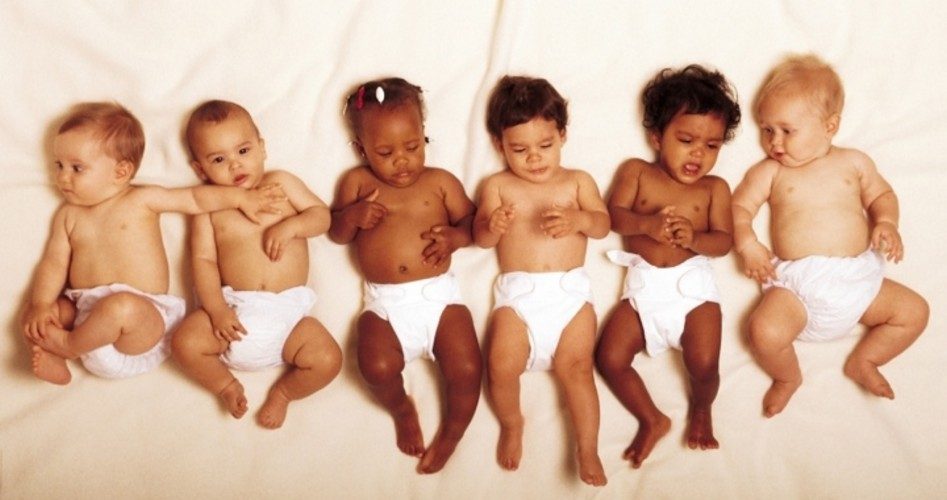
The birth rate in the United States reached an all-time low last year, while over 40 percent of all babies born in 2011 were born to unmarried women, according to a report issued last month by the Centers for Disease Control and Prevention (CDC). While the overall birth rate dropped to a record low, the birth rates for women in the 35-to-39 and 40-to-44 age brackets actually spiked from 2010 to 2011.
“The findings are based on approximately 100 percent of registered vital records occurring in calendar year 2011, which were received and processed by NCHS [National Center for Health Statistics] as of June 28, 2012,” the report stated. “The 2011 preliminary number of U.S. births was 3,953,593, 1 percent less (or 45,793 fewer) births than in 2010; the general fertility rate (63.3 per 1,000 women age 15-44 years) declined to the lowest rate ever reported for the United States.” CNS News reported:
Among all women in the United States (including those as young as 10 and as old as 54), the birth rate declined from 64.1 per 100,000 in 2010 to 63.2 per 100,000 in 2011. Among women 10 to 14 years old, it held steady at 0.4 per 100,000. Among women 15-19 years old, it declined from 34.2 to 31.3. Among women 20-24 years old, it declined from 90.0 to 85.3. Among women 25-29, it declined from 108.3 to 107.2. And among women 30-34 years old, it held steady at 96.5.
Last year, 2,347,506 babies were born to married women, while 1,606,087 were born to unmarried women — meaning 40.7 percent of babies were delivered by unmarried women. While the share of babies born to unmarried women was steepest among teenagers, the portion of newborns delivered by adult unmarried women also rose from 2010 to 2011. CNS News reported further on the CDC report:
In 2010, 33.9 percent of the babies delivered by women 25-29 were delivered by unmarried women, and in 2011 that increased to 34.4 percent. In 2010, 21.1 percent of babies delivered by women 30-34 were delivered by unmarried women, and in 2011 that increased to 21.6 percent. In 2010, 19.6 percent of babies delivered by women 35-39 were delivered by unmarried mothers and in 2011 that increased to 21.1 percent. In 2010, 21.7 percent of babies delivered by women 40 and over were delivered by unmarried mothers and in 2011 that increased to 22.4 percent.
A falling birth rate is a relatively new anomaly in the United States, as the U.S. birth rate had been consistently rising since the late 1990s, and reaching an all-time high of over 4.3 million in 2007. But fewer than 4 million births were documented last year, the smallest number since 1998.
Some demographic experts attribute the recent decline in birth rates to the poor economy, as families are reluctant to have children when they’re unemployed, underemployed, or worried about job security. “The economy is definitely having some effect on fertility and we know that from previous decades during the Great Depression we saw a pretty significant drop in fertility and then again in the 1970′s,” Mark Mather, a demographer for the research group Population Reference Bureau, said recently. “We weren’t too surprised to see a decline in fertility during this most recent economic downturn. If you look at European countries you can also see impact of high unemployment and when uncertainty about jobs, you tend to see fertility drop.”
What does a declining population mean for an economy? The total fertility rate (TFR) estimates the average number of children that would be born to a woman over her lifetime if she were to survive from birth through the end of her reproductive life. The TFR is calculated by adding the single-year, age-specific rates at a particular time.
Most importantly, the replacement fertility rate is the total birth rate at which newborn girls would deliver an average of one daughter over their lifetimes. That is, the replacement rate observes whether women have just enough female babies to replace themselves — or, similarly, adults birth just enough babies to replace themselves.
The replacement fertility rate is about 2.1 births per woman for most industrialized nations, while ranging from 2.5 to 3.3 in developing countries (due to higher mortality rates). Currently, the birth rate of children per woman in the U.S. is about 1.9, or 0.2 births below what an industrialized country needs to sustain itself.
The U.S. replacement rate, combined with the country’s exorbitant entitlement system, could singlehandedly dismantle the U.S. economy in the coming decades. If the birth rate continues to decline, and if government programs like Medicare and Social Security are not reformed, the federal government will likely endure a severe financial collapse, due to a weakened labor force that funds those programs.
Before the European economic crisis, demographers were sounding the alarm over the continent’s dreary demographic future. Indeed, the question has become, how can Europe nurture its aging population when its plummeting fertility rate looms toward a dwindling workforce in the decades to come? The U.S. birth rate has yet to reach European levels, but it’s certainly heading in that direction.
Consequently, lawmakers must reformulate how the government financially supports the elderly. If not, tax rates will skyrocket and an inflationary hailstorm will rain down on the country, leaving a severely devalued dollar, boosting unemployment to record numbers, and pushing the United States into complete economic peril.



